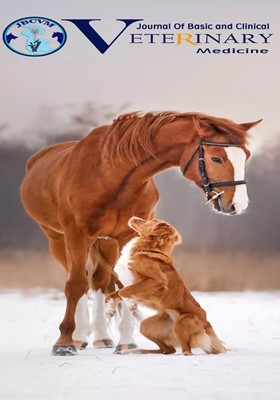A survey on species diversity and distribution of hard ticks (Acari: Ixodoidea) in cattle and buffaloes, Miandoab, Iran
Subject Areas : Parasitology
Sohrab Rasouli
1
*
![]() ,
Faezeh Haidarbeigi
2
,
Faezeh Haidarbeigi
2
![]() ,
Mahdi Seyfahmadi
3
,
Atoosa Noei
4
,
Mahdi Seyfahmadi
3
,
Atoosa Noei
4
1 - Department of Pathobiology, Faculty of Veterinary medicine, Urmia Branch, Islamic Azad University, Urmia, Iran
2 - Department of Pathobiology, Faculty of Veterinary Medicine, Urmia Branch, Islamic Azad University, Urmia, Iran
3 - Department of Biology, Faculty of Basic Sciences, Urmia Branch, Islamic Azad University, Urmia, Iran
4 - Department of Pathobiology, Faculty of Veterinary Medicine, Urmia Branch, Islamic Azad University, Urmia, Iran
Keywords: cattle, Buffalo, Miandoab, Hard Tick, Ixodidae,
Abstract :
The family of Ixodidae is one of the greatest tick families of domestic animals that includes 13 genera and 650 species in five subfamilies. The goal of this research is the assessment of the cattle and domestic buffalos’ contaminations development to differentiate the tick family from the quantitative aspect and also the determination of the found tick species diversity in Miandoab. In this study, conducted from the early spring 2016 to the late winter in 2017, 406 ticks were collected and identified from the total cattle and buffaloes studied; 187 ticks were collected and identified. From all cattle studied, Hyalomma anatolicum anatolicum, with 179 numbers (44.09%), was identified as the most infesting agent, and Boophilus annulatus, with three numbers (0.74%), was identified as the least infecting agent. From the total buffaloes under studied, Hyalomma anatolicum anatolicum, with 101 numbers (54.01%), was identified as the highest cause of infection, and Rhipicephalus sanguineus, with 21 numbers, (11.23%) was identified as the least infecting agent (P<0.05). In the current study, in terms of seasonal prevalence of hard tick infection, the highest level of infection was observed in spring and the lowest levels of infection were observed in winter (P<0.05). Maximum rates of hard ticks were observed in the groin and minimums were observed on the surface of the testicles (P<0.05).
[1] Abbasian, Lintzen. R., A preliminary list of ticks occurring in Iran and their distributional data. Acarologia. 1960; 2: 43-61.
[2] Asadi Ghorbani, M., Nemat Elahi, A., Prevalence of infection of sheep in Marand suburbs with oxidized ticks in 2003. Thesis to receive a doctor of veterinary medicine, Faculty of Veterinary Medicine, Islamic Azad University, Tabriz Branch. 2004. (In Persian).
[3] Bahrami A., Telmadarraiy Z., Vatandoost H. Survay on fauna of Ticks in west Azarbaijan province, Iran. Iranian J pub Health. 1998; Vol:33, No:4, pp:65-69.
[4] Davoudi J, Hoghooghi-Rad N, Shahrokhi-Khanghah Sh. Investigation of fauna of cattle
infected ticks and their seasonal variations in western Azarbayejan province. J Daneshe novine keshavarzi. 2007; 3(8): 15-22. (In Persian).
[5] Hashemzadeh Farhang, H. A study of the diversity of tick species in Tabriz and its suburbs. Research Plan. 2006; No. 4
[6] Kernif, T., Socolovschi, C., Wells, K., Lakim, M.B., Inthalad, S., Slesak, G., Boudebouch, N., Beaucournu, J.C., Newton, P.N., Raoult, D. & Parola, P. Bartonella and Rickettsia in arthropods from the Lao PDR and from Borneo, Malaysia. Comparative Immunology, Microbiology and Infectious Diseases. 2012; 35, 51–57.
[7] Mazlum Z. The ticks of domestic animals in Iran: Geographic distribution, host relation and seasonal activity. J vet Fac, univ Tehran, Iran. 1971; 27(1): 1-32.
[8] Minjauw B, McLeod A. Tick-borne diseases and poverty. The impact of ticks and tick-borne diseases on livestock owners in India and eastern and southern Africa. Edinburgh, UK: Health Programme, Center for Tropical Veterinary Medicine, University of Edinburgh. 2003; pp. 24-57.
[9] Nematollahi, A., Vasleimani, Sh. Arthropods and their importance in veterinary medicine and health., Volume II, Asalani Publications. 2001; Pp. 9-25
[10] Petney, T.N. & Keirans, J.E. Ticks of the genus Ixodes in South-east Asia. Tropical Biomedicine. 1994; 11, 123–134.
[11] Petney, T.N. & Keirans, J.E. Ticks of the genus Aponomma in South-east Asia. Tropical Biomedicine. 1996; 13, 167–172.
[12] Rafiei, A., and Rock.H. arthropod parasitology., University of Tehran Press. 1978; pp. 31-9. (In Persian).
[13] Rafiei, A. Veterinary and comparative protozoan. Publications of the Secretariat of the Scientific Research Council of the country. 1978. (In Persian).
[14] Ranjbar Bahadori, Sh. Study of species diversity of live ticks in Garmsar city, Journal of the Faculty of Veterinary Medicine, University of Tehran, Volume 58, Number 1, 2002; pp. 11-14.
[15] Razmi GR, Glinsharifodini M, Sarvi S. Prevalence of ixodid ticks on cattle in Mazandaran province, Iran. Korean J Parasitol. 2007; 45: 307-310.
[16] Robbins, R.G., Karesh, W.B., Rosenberg, S., Schonwalter, N. & Inthavong, C. Two noteworthy collections of ticks (Acari: Ixodida: Ixodidae) from endangered carnivores in the Lao People's Democratic Republic. Entomological News. 1996; 108, 60–62.
[17] Sajid MS, Iqbal Z, Khan MN, Muhammad GH, Khan MK. Prevalence and associated risk factors for bovine tick infestation in two districts of lower Punjab, Pakistan. Pre Vet Med. 2009; 92: 386-391.
[18] Toumanoff, C. Les tiques (Ixodoidea) de l'Indochine. Institut Pasteur de l'Indochine, S.I.L.I., Saigon. Voltzit, O.V. & Keirans, J.E. A review of Asian Amblyomma species. Acarina. 1944; 10, 95–136
[19] Walker AR, Bouattour A, Camicas JL, Estrada-Pena A, Horak IG, Latif AA, Pegram RG,Preston MM. Ticks of Domestic Animals in Africa: A Guide to Identification of Species. 1st ed. Edinburgh, UK: Bioscience Reports; 2003.
[20] Wall R., and Shearer D. Veterinary entomology.1st ed. Chapman and Hall. 1997; pp: 114-135.
[21] Yu, X.J., Liang, M.F., Zhang, S.Y., Liu, Y., Li, J.D., Sun, Y.L. and et al. Fever with thrombocytopenia associated with a novel bunyavirus in China. New England Journal of Medicine. 2011; 364, 1523–1532.

